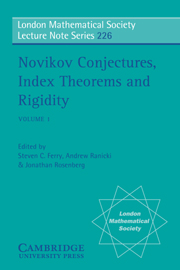A history and survey of the Novikov conjecture
Published online by Cambridge University Press: 07 May 2010
Summary
Precursors of the Novikov Conjecture
Characteristic classes
The Novikov Conjecture has to do with the question of the relationship of the characteristic classes of manifolds to the underlying bordism and homotopy theory. For smooth manifolds, the characteristic classes are by definition the characteristic classes of the tangent (or normal) bundle, so basic to this question is another more fundamental one: how much of a vector bundle is determined by its underlying spherical fibration? The Stiefel-Whitney classes of vector bundles are invariants of the underlying spherical fibration, and so the Stiefel-Whitney numbers of manifolds are homotopy invariants. Furthermore, they determine unoriented bordism. The Pontrjagin classes of vector bundles are not invariants of the underlying spherical fibration, and the Pontrjagin numbers of manifolds are not homotopy invariants. However, together with the Stiefel-Whitney numbers, they do determine oriented bordism. The essential connection between characteristic numbers and bordism was established by Thom [Th1] in the early 1950's.
Geometric rigidity
As we shall see later, the Novikov Conjecture is also closely linked to problems about rigidity of aspherical manifolds. As everyone learns in a first course in geometric topology, closed 2-manifolds are determined up to homeomorphism by their fundamental groups. In higher dimensions, of course, nothing like this is true in general, but one can still ask if aspherical closed manifolds (closed manifolds having contractible universal cover) are determined up to homeomorphism by their fundamental groups.
- Type
- Chapter
- Information
- Novikov Conjectures, Index Theorems, and RigidityOberwolfach 1993, pp. 7 - 66Publisher: Cambridge University PressPrint publication year: 1995
- 16
- Cited by



